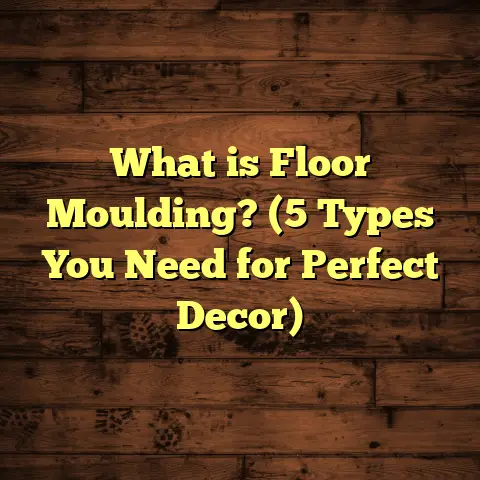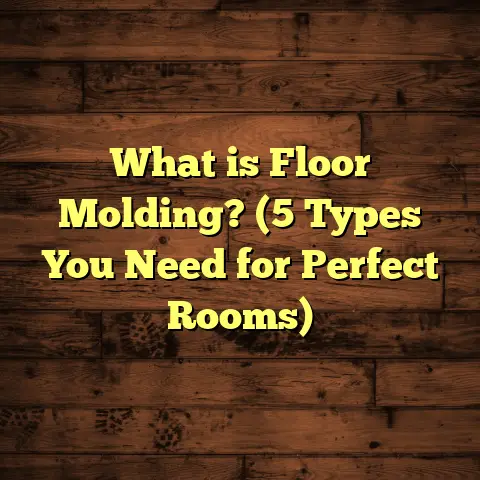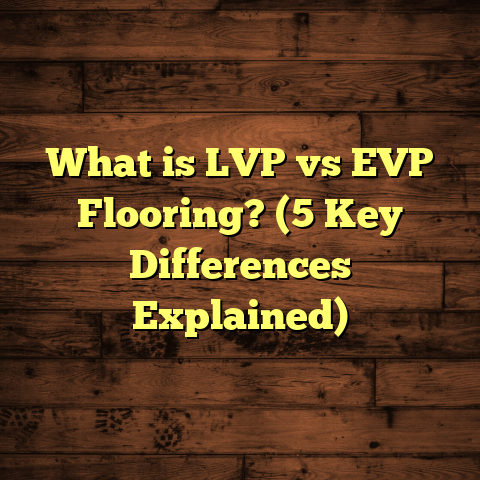What is the Floor Size of a House? (5 Key Factors Explained)
Have you ever wondered how the size of a house’s floor is determined? I mean, what really goes into figuring out the floor size, and why does it matter so much? When I first started working as a flooring contractor, this question popped up a lot. People often assume that measuring a floor is just about length times width, but it’s way more involved than that. Over the years, I’ve learned that understanding the floor size of a house is fundamental—not just for installation, but also for budgeting, design, and even resale value.
What Is the Floor Size of a House?
When I say “floor size,” I’m referring to the total area of all usable floors inside a home, usually measured in square feet or square meters. It’s not just one number slapped on a blueprint; it’s an aggregate of all the finished living spaces. This includes bedrooms, living rooms, kitchens, bathrooms—anywhere you can walk on and live in.
The floor size is often confused with the footprint of the house, but they’re not the same. The footprint only covers the ground-level area the house occupies. Floor size adds up every level—basements, attics (if finished), and multi-story areas. Think of it as the sum total of all livable spaces you can step on.
How Do Professionals Typically Measure Floor Size?
In my experience, most contractors and appraisers follow specific standards like those from ANSI (American National Standards Institute) or local building codes. The key rule is measuring inside the walls—not from the outside shell of the house.
Here’s a quick breakdown:
- Measure from interior walls edge to edge.
- Include closets and finished basements if they meet certain height requirements.
- Exclude garages, porches (unless heated and finished), and unfinished attics.
- Multi-story homes add up each floor separately.
This method gives a clear picture of usable living space that matters to homeowners.
My First Time Measuring Floor Size
I remember my very first job where I had to measure the floor size myself. It was a small 1,200 sq ft bungalow. I walked around with my tape measure and laser tool, measuring every room carefully. But then I got to the attic—it was semi-finished with sloped ceilings. Should I include that? I checked local codes and found out that parts with low ceiling height don’t count. That taught me early on just how nuanced floor size measurement can be.
Why Does Floor Size Matter?
I’ve seen this come up time and again in my projects. Knowing accurate floor size helps with:
- Material estimation: Flooring materials are sold by square footage. Overestimate and you waste money; underestimate and you run short.
- Cost budgeting: Labor costs often correlate with floor size.
- Design planning: Room layouts and furniture placement depend on knowing actual room dimensions.
- Valuation: Real estate agents use floor size to calculate market value.
Every time I start a project, the first thing I do is measure or confirm the floor size because it sets the foundation for everything else.
5 Key Factors That Affect Floor Size Calculations
Let me share some insights from my fieldwork and research about what influences floor size beyond just simple measurements.
1. Architectural Design and Layout
One of the biggest factors I’ve noticed is how the shape and structure of a house affect floor size. Think about houses with:
- Open floor plans: These can sometimes skew perception because rooms flow into each other without clear boundaries.
- Split-level homes: Each level might have different ceiling heights or partial floors.
- Irregular shapes: Bay windows, alcoves, and curved walls add complexity to measuring area accurately.
For example, in a project I worked on last year, the client had a custom home with multiple curved walls and built-in niches. Measuring that took longer than usual because I had to break down each section into smaller rectangles and triangles before totaling it all.
Dealing with Complex Shapes
When measuring complex shapes, it helps to:
- Sketch out each irregular area
- Break them into simpler shapes like rectangles or triangles
- Calculate each piece separately
- Add them all up for total area
This approach saved me hours on a Victorian home renovation where every room had unusual angles. I also use digital floor plan apps occasionally to double-check my manual calculations.
Open Floor Plans – Friend or Foe?
Open layouts are trendy now—great for socializing but tricky for measurement. Without walls separating spaces clearly, do you lump the living room and kitchen as one big area or separate zones? Usually, you measure continuous space as one large area but note functionally distinct zones for design purposes.
2. Finished vs. Unfinished Spaces
This factor can trip up many homeowners. Finished areas count toward floor size; unfinished don’t. But what exactly qualifies as “finished”?
- Walls must be drywalled or paneled.
- Floors should have permanent covering (hardwood, tile, carpet).
- Ceilings must be at least 7 feet high (some local codes say 6’8”).
- Areas must be heated/cooled for comfort.
Basement Confusion
Basements are a classic gray area. If they’re fully finished with flooring, drywall, lighting, and heating, they generally count toward finished floor area. However, unfinished or partially finished basements don’t.
In one large home I worked on in Chicago, the family finished their basement with luxury vinyl plank flooring and recessed lighting—it added roughly 900 sq ft to their living space officially recognized by appraisers.
Attic Conversions
Attics converted into bedrooms or offices can boost your floor size substantially if completed properly. However, if they lack proper insulation or heating, they often don’t count officially even if you use them regularly.
3. Ceiling Height and Volume
This is something I didn’t fully appreciate until I dealt with loft spaces and attic conversions. Floor size is strictly a two-dimensional measure, but ceiling height impacts usable space.
Many building codes require minimum ceiling heights for an area to count as living space. For example: Minimum ceiling height≈7 feet (2.13 meters)\text{Minimum ceiling height} \approx 7 \text{ feet (2.13 meters)}
If a portion of an attic has a sloped ceiling dipping below this height, that part doesn’t count toward floor size—even if you can stand there.
Real-Life Impact
On one project involving a converted attic bedroom, about 30% of the space was below 7 feet due to roof slope. That area couldn’t be counted in official measurements even though it was usable for storage or sitting.
4. Inclusion of Outdoor and Semi-Outdoor Spaces
Do decks, patios, or sunrooms add to floor size? Usually not in official terms. But here’s where definitions vary:
- Enclosed sunrooms or porches that are heated/cooled and finished may be included.
- Open decks, balconies, or patios are excluded since they’re not enclosed living areas.
- Garages are typically excluded unless converted into living space.
I once consulted on a home where the owner wanted to include an enclosed porch as part of the total floor size for selling purposes. We had to clarify that official appraisals would exclude it unless it was fully insulated and had permanent heating.
The Garage Question
Garages rarely count in total living space unless converted into bedrooms or offices with full finishing.
5. Local Building Codes and Appraisal Standards
Finally, rules vary by location. For example:
- The ANSI standard is common in the US.
- Some UK guidelines include conservatories differently.
- In Canada, finished basements are often included in total floor area if they meet standards.
When I work with clients from different states or countries, I always check local regulations first before giving final numbers.
Technical Specifications & Manufacturing Insights Related to Flooring Based on Floor Size
Once you know your floor size, here’s how it impacts what happens next in flooring installation.
Material Quantities & Waste Factor
Installing flooring isn’t just about covering the exact square footage. You need to add a waste factor due to cutting around corners, doorways, or matching patterns.
Typically:
- Laminate or hardwood: Add 5-10% extra material
- Tile: Can require up to 15% for cuts and breakage
For example, a 1,000 sq ft floor might require ordering 1,050 to 1,150 sq ft of material depending on complexity.
Why Waste Happens
When cutting planks or tiles for edges and around vents or cabinets, waste accumulates quickly. Patterned floors like herringbone require more precise cuts than straight plank installations.
Subfloor Preparation & Installation Techniques
Knowing total floor area helps calculate how much underlayment or moisture barrier you’ll need. For hardwood floors:
- Thickness varies from 3/8” to 3/4”
- Engineered hardwood planks have layers pressed together under heat and pressure for stability
- Proper acclimation time (usually 48-72 hours) is scheduled based on volume/area before installation
The Manufacturing Side of Engineered Hardwood
Engineered hardwood is made by bonding multiple layers of wood veneer under heat and pressure—a process called lamination—which increases stability against moisture changes compared to solid hardwood.
Understanding this manufacturing detail helped me advise clients choosing floors for humid climates where solid wood might warp easily.
Acclimation Importance
For large projects (2,000+ sq ft), scheduling delivery so materials sit inside the home to acclimate prevents expansion/contraction issues after installation.
My Personal Experience: How Accurate Floor Size Saved Me Thousands
On one large renovation job early in my career, I underestimated the floor size by about 200 sq ft due to ignoring finished attic space. When materials arrived, we were short on hardwood planks—and this delayed the project by days while ordering new stock.
Since then, I always measure carefully myself or double-check blueprints against physical space. Using tools like FloorTally helps me avoid costly mistakes by factoring waste and labor estimates automatically.
Data & Research: How Floor Size Impacts Home Value and Costs
According to real estate data from the National Association of Realtors:
- Each additional 100 sq ft of living space can increase home value by approximately $10,000 to $30,000, depending on region.
Construction cost estimates show that:
- Average flooring installation costs range from $5 to $15 per sq ft, varying by material.
This means an error in measuring just a few hundred sq ft can cause significant budget changes—either overspending or underestimating needed funds.
Case Study: Flooring Project for a 2,500 sq ft Home
Here’s a quick breakdown from one of my recent projects:
| Factor | Detail | Impact |
|---|---|---|
| Total measured floor size | 2,500 sq ft | Base for material calculation |
| Waste factor | 7% | Ordered 2,675 sq ft materials |
| Material type | Engineered hardwood | $10/sq ft installation cost |
| Labor time | 8 hours per 1,000 sq ft | Total ~20 hours |
| Total cost estimate | $33,750 | Material + labor |
This precise measurement helped us stick tightly to budget and schedule without surprises.
Questions You Might Be Asking
How can I measure my own floor size accurately?
Grab a tape measure or laser distance tool. Measure each room’s length and width inside walls separately; multiply to get square footage per room; then add all rooms together. Don’t forget closets! If you want to be sure, use online calculators like FloorTally—they do math plus waste allowance for you.
What if my home has weird shapes or multiple levels?
Break down complex shapes into smaller rectangles or triangles for easier calculation. Add floors separately if multi-story. Always consider ceiling height rules before including spaces.
Does flooring thickness affect floor size?
No. Floor size is surface area (2D), so thickness doesn’t change it. But thickness affects installation method and cost.
Additional Insights: Trends Affecting Floor Size Considerations in Modern Homes
Open Concept Living Increasing Complexity
With open concept designs dominating new builds and renovations, measuring distinct living spaces becomes less straightforward than ever before. People want flexible spaces that blend kitchen/dining/living areas seamlessly—which challenges traditional measurement methods relying on room boundaries.
I’ve adapted by helping clients define usable zones within open plans through furniture placement and rugs rather than walls alone.
Technology Helping Accuracy
Laser distance meters have revolutionized how I measure floors—what used to take hours now takes minutes with high accuracy. Some apps even create 3D models from room scans which help visualize total floor area instantly.
Environmental Factors & Sustainability
Eco-friendly flooring choices—like bamboo or reclaimed hardwood—are gaining popularity but sometimes come in limited plank sizes affecting waste calculations differently than standard hardwoods.
Understanding these nuances allows me to better advise clients wanting green materials without surprises in budget or installation difficulty.
Final Thoughts on Understanding Floor Size
Knowing what the floor size of a house truly means can save you hassle and money whether you’re buying materials yourself or hiring professionals like me. It’s more than just numbers—it’s about making your home comfortable, beautiful, and efficient to live in.
If you ever need help measuring or estimating your next flooring project accurately—and avoiding costly errors—just ask!





